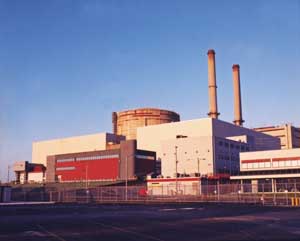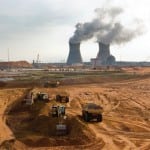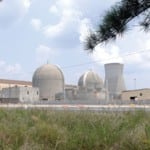The much-ballyhooed U.S. nuclear renaissance, with a few exceptions, is running late, thanks to the usual Washington bureaucratic quagmire plus the added risk resulting from crumbling financial markets. The future doesn’t look much brighter. The poor outlook for Yucca Mountain and the new administration’s general indifference to nuclear power have made a rebirth of the nuclear industry an even higher-risk proposition than before.
As the nuclear industry enters its fifth year of the much-heralded but still-awaited "nuclear renaissance," a certain industry ennui appears to have settled in. That was apparent at the Platts 5th Annual Nuclear Energy Conference in February during two days characterized by lots of sun and wind gusts of up to 50 miles per hour. Little energy was captured. There was much treading of policy water.
The local weather went unremarked-upon during the event, but there was plenty of discussion about the inability of wind or sun to supplant the very important baseload characteristics of nuclear power 24/7/365. Much ruminating focused on the uncertain political and regulatory environment for nuclear, despite the clear business and social cases that the industry believes are its underpinnings.
The nuclear industry folks seem to have adopted the "stiff upper lip" characteristic of the British in the latter days of their empire. The conference exuded the industry’s long-standing confidence that the resurgence of atomic power is so desirable — and therefore inevitable (see sidebar). No other technology responds so directly to the fears of global warming. Much has been invested; much more will come. Keep the faith, attendees seemed to say. But there was an undercurrent of doubt.
Indifferent Administrations
The reality is grim. The loan guarantees of the 2005 Energy Policy Act have, so far, proven to be a nasty chimera. A year ago at the Platts nuclear conference, the industry was beseeching the outgoing Bush administration to get the admittedly inadequate loan guarantees nailed down. The industry wanted the implementation in place before an election that could enshrine a new group of politicians and bureaucrats with a new agenda and, perhaps, a selective memory of the wishes of the previous Congress under the control of pro-nuclear Republicans.
That didn’t happen. The final Republican administration in control of implementing the 2005 law and providing for some $18 billion in nuclear loan guarantees (maybe enough to help three plants get financed) proved to be typically feckless. No loans got guaranteed. No spades turned dirt. Nobody poured concrete. Then, as the most pro-nuclear administration in recent history exited Washington, the economy collapsed. Credit? Forget it.
The nuclear industry pinned its hopes for further loan guarantees — up to $50 billion — on the Senate-passed economic stimulus bill. The father of that provision was Republican Sen. Bob Bennett of Utah (a state that has no nuclear generating plants and no prospects for any in the future). A House-Senate conference committee scrapped the $50 billion for new nukes (and loan guarantees for advanced coal-fired plants and renewables, as well as transmission). The Bennett plan drew widespread opposition from environmental groups. The fact that Bennett voted against the bill (and his own provision) in the Senate undermined his arguments.
As the Platts meeting lumbered ahead in Rockville — just an easy stroll from the White Flint, Md., headquarters of the Nuclear Regulatory Commission (NRC) a few miles down the road — the Senate Energy and Natural Resources Committee hauled up new and clueless Energy Secretary Steven Chu’s staff for a ritual beating about the head for the DOE’s failure on nuclear loan guarantees. The result was predictable: We didn’t do it, and we won’t do it again. Chu’s crew didn’t exist when the loan guarantees were pending, and they couldn’t be blamed for the failure of the agency to act. But they were the only target available, so they took the shots. Typical Washington stuff.
Democrat Jeff Bingaman of New Mexico, the committee’s chairman, and the Republican ranking member, Lisa Murkowski of Alaska (daughter of a man who recently chaired the committee — how about that for irony?) expressed predictable outrage at the DOE’s inability to issue loan guarantees and suggested the possibility of moving the decision-making to an independent agency. That, of course, is a ludicrous proposition and would delay any loan guarantee decisions into the unforeseeable future. It was predictable congressional grandstanding. To quote Shakespeare, it was "a tale told by an idiot, full of sound and fury, signifying nothing."
At the Platts meeting, Jeff Lyash, CEO of Progress Energy Florida, outlined one of the big problems with the DOE nuclear loan guarantee program. Florida Progress, he noted, applied in the first round of the DOE program for its planned two-unit new nuke but declined to go beyond that to stage two (Figure 1). That’s because the DOE loan guarantee requires that a first lien on the asset goes to the government. Unacceptable, said Lyash. Florida law requires the first mortgage on the asset to be on the books of the utility. In addition, he said, Florida’s municipal and cooperative utilities could not participate under the DOE’s lien terms, further poisoning the financial pond. So Florida Progress, a conventionally regulated utility, will not seek DOE loan guarantees.

1. Additions to the family. Progress Energy Florida has teamed with Westinghouse Electric Co. LLC and The Shaw Group Inc.’s Power Group for the engineering, procurement, and construction of two nuclear units for a proposed nuclear power plant in Levy County, Fla. Each unit will be rated at 1,105 MW and powered by a Westinghouse AP1000 reactor. The project schedule has the units operational in the 2016 to 2018 time frame. In addition to the single-unit 838-MW Crystal River Plant shown here, Progress Energy owns the two-unit Brunswick Nuclear Plant, the single-unit Harris Nuclear Plant, and the single-unit Robinson Nuclear Plant. Courtesy: NRC
Get It Right This Time
One theme at the Platts meeting, reiterating the previous four years of nuclear renaissance hype, was, "We’ve got to get it right this time." That’s a reference to the failures of the nuclear industry in the 1970s and 1980s that led to the industry’s legendary flameout.
But that "get it right" mantra may not match reality, according to NRC Commissioner Gregory Jaczko, who led off the Platts conference. Many insiders believe Jaczko, a PhD physicist with anti-nuclear ties, will be the new NRC chairman in the Obama administration. Jaczko was the scientific advisor to Senate Majority Leader Harry Reid (D-Nev.) and a staff advisor to Rep. Ed Markey (D-Mass.), one of the nuclear industry’s most dogged critics.
Addressing the Platts meeting, Jaczko said we may be seeing a reprise of the bad old days. He noted that the 2005 law precipitated an avalanche of applications for the new NRC combined construction and operating licenses for new nuclear plants. The law required that the applications be filed by the end of 2008 in order to be eligible for the goodies (including loan guarantees) in the new law. That, he told the meeting, "led utilities that are probably not as close to a decision about whether to build to at least apply."
As a result, said Jaczko, "we now find ourselves again making some of the same mistakes of the past. One of the challenges of the 1960s, 70s, 80s was that applicants, vendors, and the regulator were attempting to do everything — designs, site/environmental issues, and applications — all at once."
Jaczko noted that the NRC has received 17 combined license applications before reactor designs are complete and certified (Figure 2). "We have approved three early site permits," he said, "but for sites where utilities have not yet decided to move forward aggressively. All of this is certainly allowed under our regulation, but I do not believe it is the most efficient or predictable path forward."

2. Location of projected new nuclear plants. Source: NRC
Furthering Jaczko’s observations, UniStar Nuclear Energy (born of Constellation Energy and EDF Group) CEO George Vanderheyden told the meeting that he expects that the NRC will grant a combined construction and operating license for his company’s plans for a new two-unit AREVA plant at the existing Calvert Cliffs, Md., site before the commission approves the AREVA reactor design. The reactor design certification, he said, "is the critical path" for the new plant. AREVA’s evolutionary design, a French pressurized water reactor, is pending at the NRC.
That troubles Jaczko. The NRC staff, said Jaczko, recently proposed to the commission a path to "further streamline the design certification rulemaking process. The intentions here are good — developing templates, optimizing processes, providing better information earlier — but the goal of this effort is grounded simply in achieving a shorter schedule. While efficiency is good, the magnitude of the time savings staff is looking at is dwarfed by the delays being caused incomplete applications and technical issues."
Jaczko, to the considerable dismay of his industry audience, praised the delay that today’s marketplace is placing on generating projects. "I firmly believe," he said, "the benefit of the more reserved atmosphere we find ourselves in today is that everyone involved in this journey has an opportunity to look at their core mission, refocus on what matters, and plan for a safe and efficient long-term future."
The delays ahead, said Jaczko, are largely caused by extrinsic forces, such as the current financial crisis and the difficulties in lining up debt financing. Nonetheless, he said, the "NRC should take advantage of the opportunity those delays give us to reinvest in safety."
—Kennedy Maize is a POWER contributing editor and executive editor of its online sister publication MANAGING POWER
(www.managingpowermag.com).









